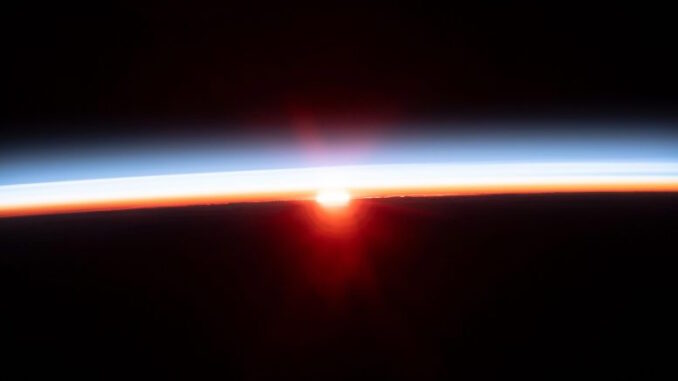
The awe-inspiring beauty of Earth is not just limited to those who inhabit its surface. Astronauts aboard the International Space Station (ISS) are bestowed with a unique vantage point, providing them with the opportunity to capture breathtaking moments, such as the spectacular sunrise observed on September 29, 2023.
The Astronaut's Glimpse
As the ISS orbited over the southern Indian Ocean, an astronaut turned their gaze eastward and immortalized the mesmerizing event - the Sun rising above Earth's horizon. This image, captured with a Nikon D5 digital camera, showcases the delicate dance of light and shadow, offering a celestial symphony that only a few privileged individuals get to witness.
Layers of Earth's Atmosphere Unveiled
The photograph not only captures the celestial drama but also unveils the layers of Earth's atmosphere. The edge-on perspective showcases the troposphere, adorned in hues of orange and red, a canvas painted by the scattering of sunlight through particles of dust, smoke, and smog. Just above lies the stratosphere, a serene blue expanse that extends up to 50 kilometers (30 miles) above the Earth's surface. Further up, the mesosphere completes this layered spectacle.
NASA's Heliophysics Big Year
In the foreground of this celestial ballet is the Sun, a focal point in NASA's Heliophysics Big Year celebration. Initiated with the annular solar eclipse in October 2023, this year-long jubilee continues with a total solar eclipse slated for April 2024, concluding with the Parker Solar Probe's closest approach to the Sun in December 2024.
Eclipses as a Gateway to Understanding
The upcoming total solar eclipse in April 2024 is more than just a cosmic spectacle. Its path over Mexico, the United States, and Canada presents an invaluable opportunity for scientists to delve into the Sun's influence on Earth's ionosphere. This region, spanning from approximately 80 to 600 kilometers (50 to 400 miles) above Earth's surface, is a critical area where the atmosphere meets space, influencing satellite communications, including those on the ISS.
Astronauts' Unique View on Solar Events
Astronauts aboard the ISS are not mere spectators to these celestial phenomena; they actively contribute to scientific understanding. During a solar eclipse, they may witness the Moon's shadow passing over Earth, providing a unique perspective that aids researchers on the ground. However, the astronauts' more frequent encounters involve witnessing up to 16 sunrises every 24 hours, reminding them of Earth's constant rotation and the beauty of the cosmos.
Capturing the Moment
The showcased photograph, ISS070-E-1178, taken by a member of the Expedition 70 crew, has undergone careful enhancement to improve contrast, remove lens artifacts, and ensure it provides the greatest value to scientists and the public. These images, made possible through the support of the International Space Station Program, are freely shared on the internet, contributing to humanity's collective awe and understanding of our planet and the universe beyond.
In the grand theater of space, where Earth and Sun perform their celestial ballet, the ISS stands as a stage from which humanity can witness and marvel at the cosmic wonders that unfold before our eyes. As we look to the skies and beyond, each photograph captured from the space station serves as a reminder of our small yet significant place in the vast expanse of the cosmos.
Leave a Reply